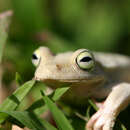en
names in breadcrumbs


The emerald-eyed tree frog (Boana crepitans) is a species of frog in the family Hylidae. It is largely restricted to the Atlantic Forest region of Brazil. Some populations previously regarded as Boana crepitans have been separated into the species Boana xerophylla and Boana platanera.[2]
Species description based on Ibanez et al. (1999) and Duellman (2001). A large treefrog with long, slender arms and legs (males to 59 mm, females to 68 mm). Males have a dagger-like spine at the base of the thumb.
The dorsal surface is pinkish tan with some darker brown spots, blotches or other markings. A thin, dark middorsal stripe is usually present. Dark bars are present on the upper surfaces of the thighs, and extend onto the rear surfaces of the thighs.
The concealed surfaces are colored similarly to the dorsum, except for the dark barring on the rear surfaces of the thighs.
The eye is grey, with a bronzy or yellowish cast.
The webbing between the hands and feet is not particularly extensive in Hypsiboas crepitans. The webbing is pale in coloration.
This species has a variety of habitats, ranging from humid tropical forests, semiarid environments, grasslands, llanos, intervening habitats, pastures and lower montane forests. It is an arboreal nocturnal species, found on leaves of trees, on shrubs and other vegetation near watercourses. The species breeds in temporary pools at the beginning of the rainy season. Specimens are occasionally also found on the ground. It is possible to find this species in severely degraded habitats including urban areas and human dwellings.
Breeding occurs throughout much of the rainy season (Ibanez et al. 1999, Duellman 2001). Males call from the edges of temporary ponds or flooded grassy areas (Ibanez et al. 1999).
Females may lay over 1,000 eggs in a single oviposition event.[3]
Tadpoles are grey or light brown (Duellman 2001). The tail has more yellow undertones (Duellman 2001). The tadpole body is ovoid, with a rather long tail that ends in a distinct point (Duellman 2001). The upper caudal fin is much deeper than the lower (Duellman 2001).
{{cite journal}}: CS1 maint: multiple names: authors list (link) The emerald-eyed tree frog (Boana crepitans) is a species of frog in the family Hylidae. It is largely restricted to the Atlantic Forest region of Brazil. Some populations previously regarded as Boana crepitans have been separated into the species Boana xerophylla and Boana platanera.
La rana blanca, rana cantora, rana capina, o rana platanera (Boana crepitans) es una especie de anfibios de la familia Hylidae.
Habita en México, Brasil, Colombia, República Dominicana, Guayana Francesa, Panamá, Surinam, Trinidad y Tobago y Venezuela.[2]
Sus hábitats naturales incluyen bosques tropicales o subtropicales secos, sabanas secas y húmedas, ríos, corrientes intermitentes de agua, lagos de agua dulce, marismas de agua dulce, manantiales, deltas fluviales, tierra arable, pastos, plantaciones, jardines rurales, áreas urbanas, zonas previamente boscosas ahora muy degradadas, zonas de almacenamiento de agua como estanques y depósitos de acuicultura, tierras de irrigación y zonas agrícolas inundadas.
La rana blanca, rana cantora, rana capina, o rana platanera (Boana crepitans) es una especie de anfibios de la familia Hylidae.
Hypsiboas crepitans Hypsiboas generoko animalia da. Anfibioen barruko Hylidae familian sailkatuta dago, Anura ordenan.
Hypsiboas crepitans est une espèce d'amphibiens de la famille des Hylidae[1].
Cette espèce se rencontre jusqu'à 2 300 m d'altitude dans deux régions disjointes[1],[2] :
Hypsiboas crepitans est une espèce d'amphibiens de la famille des Hylidae.
Boana crepitans[2] é uma espécie de anfíbio da família Hylidae. Pode ser encontrada no Brasil, Colômbia, Panamá, Venezuela, Guiana, Suriname, Guiana Francesa e Trinidad e Tobago.[3]
Boana crepitans é uma espécie de anfíbio da família Hylidae. Pode ser encontrada no Brasil, Colômbia, Panamá, Venezuela, Guiana, Suriname, Guiana Francesa e Trinidad e Tobago.